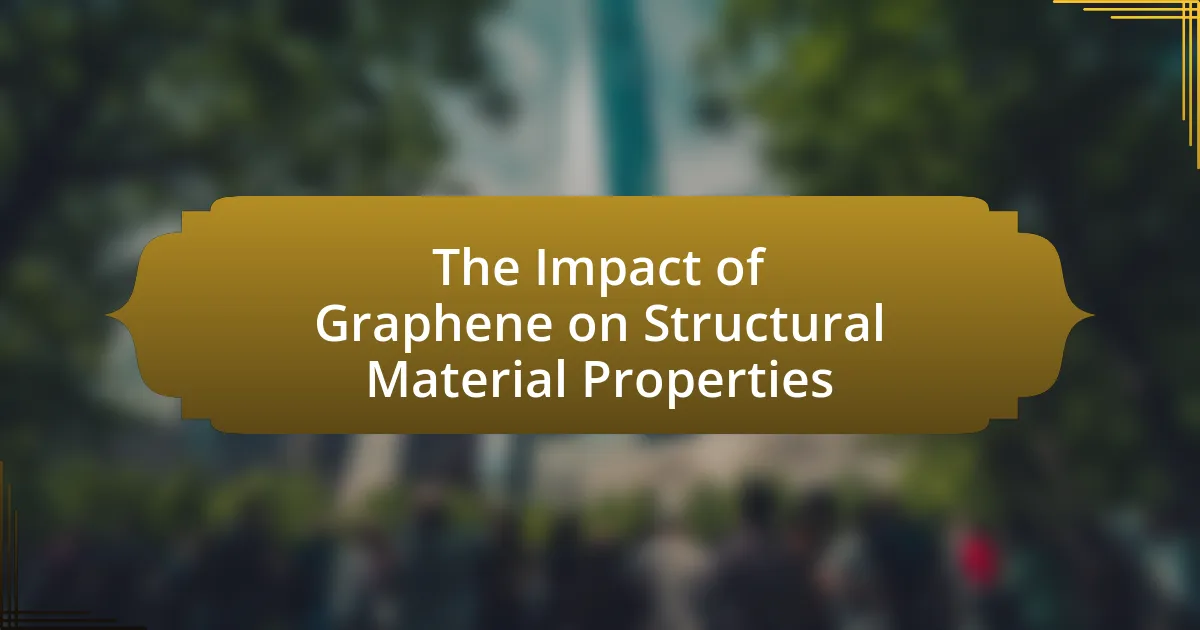Graphene, a single layer of carbon atoms, is recognized for its transformative impact on structural material properties, significantly enhancing strength, flexibility, and conductivity. With a tensile strength over 200 times that of steel and exceptional electrical and thermal conductivity, graphene is poised to revolutionize industries such as aerospace, automotive, and construction. This article explores how graphene improves mechanical properties, its applications in various sectors, and the challenges associated with its production and integration into materials. Additionally, it discusses strategies for optimizing graphene composites and the future trends anticipated in graphene technology.

What is the Impact of Graphene on Structural Material Properties?
Graphene significantly enhances the structural material properties by improving strength, flexibility, and conductivity. Specifically, graphene exhibits a tensile strength of approximately 130 GigaPascals, making it over 200 times stronger than steel while remaining lightweight. This remarkable strength-to-weight ratio allows for the development of materials that can withstand greater stress and strain without failure. Additionally, graphene’s high electrical and thermal conductivity, with values around 6000 S/m and 5000 W/m·K respectively, enables the creation of advanced composites that can efficiently dissipate heat and conduct electricity. These properties make graphene an ideal additive in various structural applications, including aerospace, automotive, and construction materials, leading to innovations in design and performance.
How does graphene enhance the properties of structural materials?
Graphene enhances the properties of structural materials by significantly increasing their strength, flexibility, and conductivity. Specifically, graphene’s tensile strength is approximately 200 times greater than that of steel, allowing materials to withstand greater loads without deformation. Additionally, graphene improves the flexibility of materials, enabling them to bend without breaking, which is crucial for applications in construction and manufacturing. Furthermore, graphene’s exceptional electrical and thermal conductivity enhances the performance of composite materials, making them suitable for advanced applications in electronics and energy storage. These enhancements are supported by studies, such as those published in “Nature Nanotechnology,” which demonstrate that incorporating graphene into polymers can lead to a 50% increase in tensile strength and a 30% improvement in electrical conductivity.
What specific mechanical properties are improved by graphene?
Graphene significantly improves tensile strength, elasticity, and hardness in materials. Specifically, graphene can enhance the tensile strength of composites by up to 200% compared to traditional materials, while also increasing their elasticity, allowing for greater deformation without permanent damage. Additionally, graphene contributes to increased hardness, making materials more resistant to wear and tear. These improvements are supported by studies demonstrating that graphene-reinforced materials exhibit superior mechanical performance, making them suitable for advanced applications in various industries.
How does graphene influence thermal conductivity in materials?
Graphene significantly enhances thermal conductivity in materials due to its unique two-dimensional structure and high intrinsic thermal conductivity, which can exceed 5000 W/mK. This exceptional property arises from the strong sp2 hybridized carbon-carbon bonds within graphene, allowing efficient phonon transport. Studies have shown that incorporating graphene into composite materials can lead to a substantial increase in thermal conductivity; for instance, a research article published in the journal “Advanced Materials” by Nair et al. (2010) demonstrated that adding graphene oxide to epoxy resins improved thermal conductivity by up to 300%. Thus, graphene serves as a critical additive for improving thermal management in various applications.
Why is graphene considered a revolutionary material in construction?
Graphene is considered a revolutionary material in construction due to its exceptional strength, lightweight nature, and electrical conductivity. It is approximately 200 times stronger than steel while being only one atom thick, which allows for the creation of stronger and lighter structures. Additionally, graphene’s high electrical conductivity can enhance the performance of smart building materials, enabling features such as self-sensing and energy-efficient systems. Research published in the journal “Nature” by Novoselov et al. highlights graphene’s unique properties, demonstrating its potential to significantly improve the durability and efficiency of construction materials.
What advantages does graphene offer over traditional materials?
Graphene offers superior strength, electrical conductivity, and thermal conductivity compared to traditional materials. Specifically, graphene is approximately 200 times stronger than steel while being incredibly lightweight, making it ideal for applications requiring high strength-to-weight ratios. Additionally, graphene exhibits exceptional electrical conductivity, surpassing that of copper, which enhances its utility in electronic devices. Its thermal conductivity is also remarkable, allowing for efficient heat dissipation in various applications. These properties have been validated through numerous studies, including research published in “Nature” by Novoselov et al., which highlights graphene’s unique characteristics and potential applications in advanced materials.
How does the incorporation of graphene affect material weight and strength?
The incorporation of graphene significantly reduces material weight while enhancing strength. Graphene, a single layer of carbon atoms arranged in a two-dimensional lattice, is known for its exceptional mechanical properties, including a tensile strength of approximately 130 GigaPascals, which is over 100 times stronger than steel. When added to composite materials, graphene can lead to a reduction in weight by replacing heavier components without compromising structural integrity. Studies have shown that composites reinforced with graphene exhibit improved strength-to-weight ratios, making them ideal for applications in aerospace and automotive industries. For instance, research published in the journal “Nature” by Novoselov et al. demonstrates that graphene-enhanced materials can achieve significant weight savings while maintaining or increasing strength, validating the transformative impact of graphene on material properties.

What are the applications of graphene in structural materials?
Graphene is utilized in structural materials primarily to enhance mechanical strength, reduce weight, and improve electrical conductivity. Its incorporation into composites, such as polymers and metals, significantly increases tensile strength and stiffness, making materials more durable and lightweight. For instance, research has shown that adding just a small percentage of graphene can increase the tensile strength of epoxy resins by up to 200%. Additionally, graphene’s exceptional electrical properties enable the development of conductive composites, which are essential in applications like smart materials and sensors. These advancements demonstrate graphene’s transformative impact on the performance and functionality of structural materials.
In which industries is graphene being utilized for structural applications?
Graphene is being utilized for structural applications primarily in the aerospace, automotive, construction, and electronics industries. In aerospace, graphene enhances the strength-to-weight ratio of materials, improving fuel efficiency and performance. The automotive industry benefits from graphene’s ability to reinforce composites, leading to lighter and stronger vehicle components. In construction, graphene is incorporated into concrete and other materials to increase durability and reduce weight. Additionally, the electronics sector utilizes graphene for its excellent electrical conductivity, enabling the development of advanced electronic components. These applications are supported by research demonstrating graphene’s superior mechanical properties and its potential to revolutionize material science across various sectors.
How is graphene used in the aerospace industry?
Graphene is used in the aerospace industry primarily to enhance the mechanical properties of composite materials. Its incorporation into materials such as carbon fiber composites significantly improves strength, stiffness, and thermal conductivity, which are critical for aerospace applications. For instance, research published in the journal “Advanced Materials” demonstrates that adding graphene to epoxy resins can increase tensile strength by up to 50% and improve thermal conductivity by 200%. These enhancements contribute to lighter, more efficient aircraft structures, ultimately leading to reduced fuel consumption and improved performance.
What role does graphene play in civil engineering projects?
Graphene enhances civil engineering projects by improving the mechanical properties of construction materials. Its incorporation into concrete, for instance, increases strength, durability, and resistance to cracking. Studies have shown that adding graphene oxide to cement can enhance compressive strength by up to 50% and reduce permeability, leading to longer-lasting structures. Additionally, graphene’s lightweight nature contributes to reduced material usage and lower transportation costs, making it a valuable asset in sustainable construction practices.
What challenges are associated with the use of graphene in materials?
The challenges associated with the use of graphene in materials include difficulties in large-scale production, integration into existing manufacturing processes, and maintaining uniform quality. Large-scale production of graphene remains a significant hurdle due to the complexity and cost of synthesis methods, such as chemical vapor deposition and liquid-phase exfoliation. Additionally, integrating graphene into composite materials often leads to issues with dispersion and compatibility, which can affect the mechanical properties of the final product. Maintaining uniform quality is crucial, as variations in graphene’s structure can lead to inconsistent performance in applications. These challenges hinder the widespread adoption of graphene in various industries, despite its promising properties.
What are the production challenges of graphene for commercial use?
The production challenges of graphene for commercial use include scalability, cost, and quality control. Scalability remains a significant hurdle as current methods, such as chemical vapor deposition and liquid-phase exfoliation, struggle to produce large quantities of high-quality graphene efficiently. The cost of production is also high, with estimates suggesting that producing graphene can exceed $100 per gram, making it economically unfeasible for widespread applications. Additionally, maintaining consistent quality is difficult, as variations in the production process can lead to defects in the graphene structure, which adversely affects its properties and performance in applications. These challenges hinder the integration of graphene into commercial products, limiting its potential impact on structural material properties.
How do cost factors influence the adoption of graphene in structural materials?
Cost factors significantly influence the adoption of graphene in structural materials by determining the feasibility of its integration into manufacturing processes. High production costs of graphene, which can exceed $100 per gram for high-quality materials, limit its widespread use in industries that prioritize cost-effectiveness. Additionally, the economic viability of graphene is affected by the availability of scalable production methods; for instance, methods like chemical vapor deposition are expensive and complex, hindering large-scale application. Research indicates that reducing the cost of graphene production through innovative techniques, such as liquid-phase exfoliation, could enhance its adoption, as evidenced by studies showing potential cost reductions of up to 90%. Thus, cost factors play a crucial role in the decision-making process for industries considering graphene as a structural material.

How can the benefits of graphene in structural materials be maximized?
The benefits of graphene in structural materials can be maximized by optimizing its dispersion and alignment within the matrix of the composite material. Effective dispersion ensures that graphene’s exceptional mechanical properties, such as high tensile strength and stiffness, are fully utilized. Research indicates that incorporating graphene at a concentration of 0.1% to 1% by weight can significantly enhance the mechanical properties of polymers, as demonstrated in studies like “Graphene Reinforced Polymers: A Review” by A. A. B. A. Rahman et al., published in the Journal of Materials Science. Furthermore, aligning graphene sheets during the manufacturing process can improve load transfer efficiency, leading to enhanced performance in structural applications.
What best practices should be followed when integrating graphene into materials?
To effectively integrate graphene into materials, it is essential to ensure uniform dispersion of graphene within the matrix. This practice enhances the mechanical and electrical properties of the composite material. Achieving uniform dispersion can be accomplished through methods such as sonication, high shear mixing, or using surfactants to prevent agglomeration. Research indicates that composites with well-dispersed graphene exhibit significantly improved tensile strength and conductivity, as demonstrated in studies like “Graphene-based composites: A review” published in the Journal of Materials Science by authors Zhang et al. (2019). Additionally, optimizing the graphene content is crucial; too little may not yield significant improvements, while too much can lead to phase separation. Therefore, a systematic approach to varying graphene concentrations during material formulation is recommended to identify the optimal balance for desired properties.
How can testing and quality assurance improve graphene-enhanced materials?
Testing and quality assurance can significantly improve graphene-enhanced materials by ensuring their performance, reliability, and safety through systematic evaluation and validation processes. Rigorous testing methods, such as mechanical property assessments and thermal conductivity measurements, allow for the identification of optimal graphene concentrations and dispersion techniques, which directly influence the material’s strength and conductivity. Quality assurance protocols, including standardized testing procedures and compliance with industry regulations, help maintain consistency in production, thereby reducing defects and enhancing the overall quality of the materials. For instance, studies have shown that materials with well-dispersed graphene exhibit up to 200% increased tensile strength compared to their non-enhanced counterparts, highlighting the importance of thorough testing in achieving desired material properties.
What strategies can be employed to optimize the performance of graphene composites?
To optimize the performance of graphene composites, strategies include enhancing dispersion of graphene within the matrix, adjusting the graphene content, and utilizing surface modifications. Enhanced dispersion improves the interfacial bonding between graphene and the matrix, which is crucial for maximizing mechanical properties. Research indicates that achieving a uniform distribution of graphene can significantly increase tensile strength and electrical conductivity. Adjusting the graphene content allows for tuning the composite’s properties; studies show that optimal loading levels can lead to improved thermal and mechanical performance without compromising flexibility. Surface modifications, such as functionalization, can improve compatibility with the matrix, further enhancing the overall performance of the composite.
What future trends can we expect in the use of graphene for structural materials?
Future trends in the use of graphene for structural materials include increased integration into composites, enhanced mechanical properties, and advancements in manufacturing techniques. Research indicates that graphene can significantly improve the strength-to-weight ratio of materials, making them more efficient for construction and aerospace applications. For instance, a study published in the journal “Nature” demonstrated that graphene-reinforced composites exhibited up to 200% increase in tensile strength compared to traditional materials. Additionally, the development of scalable production methods, such as chemical vapor deposition, is expected to facilitate widespread adoption of graphene in various structural applications, further driving innovation in the field.
How might advancements in graphene technology shape future construction methods?
Advancements in graphene technology are likely to revolutionize future construction methods by enabling the development of stronger, lighter, and more durable materials. Graphene’s exceptional tensile strength, which is over 200 times that of steel, allows for the creation of structures that can withstand greater loads while using less material. This reduction in material usage not only lowers costs but also minimizes the environmental impact associated with construction. Additionally, graphene’s conductivity can lead to the integration of smart technologies within building materials, enhancing energy efficiency and sustainability. Research published in the journal “Nature” by Novoselov et al. highlights graphene’s potential in composite materials, indicating that its incorporation can significantly improve mechanical properties. Thus, the integration of graphene into construction practices is poised to enhance structural integrity and sustainability in the built environment.
What potential innovations could arise from ongoing graphene research?
Ongoing graphene research could lead to innovations such as advanced composite materials, flexible electronics, and high-capacity batteries. Graphene’s exceptional strength-to-weight ratio and electrical conductivity make it ideal for creating lightweight, durable materials that can enhance structural integrity in various applications, including aerospace and automotive industries. For instance, incorporating graphene into polymers can significantly improve their mechanical properties, as demonstrated in studies showing up to 200% increase in tensile strength. Additionally, graphene’s unique properties enable the development of flexible electronic devices, which can revolutionize consumer electronics by allowing for bendable screens and wearable technology. Furthermore, graphene’s high surface area and conductivity can enhance battery performance, potentially leading to faster charging times and increased energy storage capacity, as evidenced by research indicating that graphene-based batteries can achieve up to 10 times the capacity of traditional lithium-ion batteries.

Leave a Reply